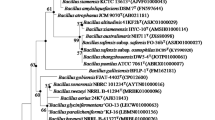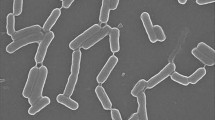Abstract
Lactic acid bacteria (LAB) frequently contaminate commercial fuel ethanol fermentations, reducing yields and decreasing profitability of biofuel production. Microorganisms from environmental sources in different geographic regions of Thailand were tested for antibacterial activity against LAB. Four bacterial strains, designated as ALT3A, ALT3B, ALT17, and MR1, produced inhibitory effects on growth of LAB. Sequencing of rRNA identified these strains as species of Bacillus subtilis (ALT3A and ALT3B) and B. cereus (ALT17 and MR1). Cell mass from colonies and agar samples from inhibition zones were analyzed by matrix-assisted laser desorption/ionization-time of flight mass spectrometry. The spectra of ALT3A and ALT3B showed a strong signal at m/z 1,060, similar in mass to the surfactin family of antimicrobial lipopeptides. ALT3A and ALT3B were analyzed by zymogram analysis using SDS-PAGE gels placed on agar plates inoculated with LAB. Cell lysates possessed an inhibitory protein of less than 10 kDa, consistent with the production of an antibacterial lipopeptide. Mass spectra of ALT17 and MR1 had notable signals at m/z 908 and 930 in the whole cell extracts and at m/z 687 in agar, but these masses do not correlate with those of previously reported antibacterial lipopeptides, and no antibacterial activity was detected by zymogram. The antibacterial activities produced by these strains may have application in the fuel ethanol industry as an alternative to antibiotics for prevention and control of bacterial contamination.




Similar content being viewed by others
References
Agata N, Mori M, Ohta M, Suwan S, Ohtani I, Isobe M (1994) A novel dodecadepsipeptide, cereulide, isolated from Bacillus cereus causes vacuole formation in HEp-2 cells. FEMS Microbiol Lett 121:31–34
Altschul SF, Madden TL, Schaffer AA, Zhang J, Zhang Z, Miller W, Lipman DJ (1997) Gapped BLAST and PSI-BLAST: a new generation of protein database search programs. Nucleic Acids Res 25:3389–3402
Bernheimer AW, Avigad LS (1970) Nature and properties of a cytolytic agent produced by Bacillus subtilis. J Gen Microbiol 61:361–369
Bischoff KM, Skinner-Nemec KA, Leathers TD (2007) Antimicrobial susceptibility of Lactobacillus species isolated from commercial ethanol plants. J Ind Microbiol Biotechnol 34:739–744
Bischoff KM, Liu S, Leathers TD, Worthington RE, Rich JO (2009) Modeling bacterial contamination of fuel ethanol fermentation. Biotechnol Bioeng 103:117–122
Bizani D, Dominguez AP, Brandelli A (2005) Purification and partial chemical characterization of the antimicrobial peptide cerein 8A. Lett Appl Microbiol 41:269–273
Chatterjee S, Chatterjee S, Lad SJ, Phansalkar MS, Rupp RH, Ganguli BN, Fehlhaber HW, Kogler H (1992) Mersacidin, a new antibiotic from Bacillus. Fermentation, isolation, purification and chemical characterization. J Antibiot (Tokyo) 45:832–838
Hassan M, Kjos M, Nes IF, Diep DB, Lotfipour F (2012) Natural antimicrobial peptides from bacteria: characteristics and potential applications to fight against antibiotic resistance. J Appl Microbiol 113:723–736
Kowall M, Vater J, Kluge B, Stein T, Franke P, Ziessow D (1998) Separation and characterization of surfactin isoforms produced by Bacillus subtilis OKB 105. J Colloid Interface Sci 204:1–8
Landman D, Georgescu C, Martin DA, Quale J (2008) Polymyxins revisited. Clin Microbiol Rev 21:449–465
Lu JJ, Perng CL, Lee SY, Wan CC (2000) Use of PCR with universal primers and restriction endonuclease digestions for detection and identification of common bacterial pathogens in cerebrospinal fluid. J Clin Microbiol 38:2076–2080
Makanjuola DB, Tymon A, Springham DG (1992) Some effects of lactic-acid bacteria on laboratory-scale yeast fermentations. Enzym Microb Technol 14:350–357
Manitchotpisit P, Leathers TD, Peterson SW, Kurtzman CP, Li XL, Eveleigh DE, Lotrakul P, Prasongsuk S, Dunlap CA, Vermillion KE, Punnapayak H (2009) Multilocus phylogenetic analyses, pullulan production and xylanase activity of tropical isolates of Aureobasidium pullulans. Mycol Res 113:1107–1120
Mannanov RN, Sattarova RK (2001) Antibiotics produced by Bacillus bacteria. Chem Nat Compd 37:117–123
Naclerio G, Ricca E, Sacco M, De Felice M (1993) Antimicrobial activity of a newly identified bacteriocin of Bacillus cereus. Appl Environ Microbiol 59:4313–4316
Narendranath NV (2003) Bacterial contamination and control in ethanol production. In: Jacques KA, Lyons TP, Kelsall DR (eds) The alcohol textbook, 4th edn. Nottingham University Press, Nottingham, pp 287–298
Narendranath NV, Hynes SH, Thomas KC, Ingledew WM (1997) Effects of lactobacilli on yeast-catalyzed ethanol fermentations. Appl Environ Microbiol 63:4158–4163
Ongena M, Jacques P (2008) Bacillus lipopeptides: versatile weapons for plant disease biocontrol. Trends Microbiol 16:115–125
Oscaíriz JC, Lasa I, Pisabarro AG (1999) Detection and characterization of cerein 7, a new bacteriocin produced by Bacillus cereus with a broad spectrum of activity. FEMS Microbiol Lett 178:337–341
Parisot J, Carey S, Breukink E, Chan WC, Narbad A, Bonev B (2008) Molecular mechanism of target recognition by subtilin, a class I lanthionine antibiotic. Antimicrob Agents Chemother 52:612–618
Price NP, Rooney AP, Swezey JL, Perry E, Cohan FM (2007) Mass spectrometric analysis of lipopeptides from Bacillus strains isolated from diverse geographical locations. FEMS Microbiol Lett 271:83–89
Risoen PA, Ronning P, Hegna IK, Kolsto AB (2004) Characterization of a broad range antimicrobial substance from Bacillus cereus. J Appl Microbiol 96:648–655
Skinner-Nemec KA, Leathers TD (2004) Bacterial contaminants of fuel ethanol production. J Ind Microbiol Biotechnol 31:401–408
Skinner-Nemec KA, Nichols NN, Leathers TD (2007) Biofilm formation by bacterial contaminants of fuel ethanol production. Biotechnol Lett 29:379–383
Stein T (2005) Bacillus subtilis antibiotics: structures, syntheses and specific functions. Mol Microbiol 56:845–857
Author information
Authors and Affiliations
Corresponding author
Additional information
Mention of a trade name, proprietary product, or specific equipment does not constitute a guarantee or warranty by the United States Department of Agriculture and does not imply its approval to the exclusion of other products that may be suitable. USDA is an equal opportunity provider and employer.
Rights and permissions
About this article
Cite this article
Manitchotpisit, P., Bischoff, K.M., Price, N.P.J. et al. Bacillus spp. Produce Antibacterial Activities Against Lactic Acid Bacteria that Contaminate Fuel Ethanol Plants. Curr Microbiol 66, 443–449 (2013). https://doi.org/10.1007/s00284-012-0291-4
Received:
Accepted:
Published:
Issue Date:
DOI: https://doi.org/10.1007/s00284-012-0291-4




